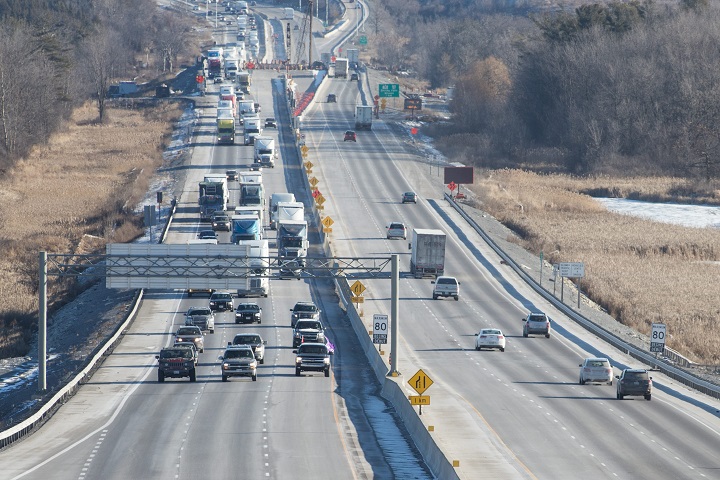One in three Canadians lives near a major road, and that means they’re breathing in a lot of vehicle exhaust, according to a new study.

The study, released by the University of Toronto’s Southern Ontario Center for Atmospheric Aerosol Research, measured air pollution in a few locations in Toronto and Vancouver over the course of two years.
They found that traffic was a big source of nitrogen dioxide, ultrafine particles and black carbon near roads — all of which have been associated with adverse health outcomes like asthma, birth and developmental concerns, cancer, and cardiovascular and respiratory mortality.
But it’s not just the volume of traffic that causes pollution, said study author Greg Evans, a professor of chemical engineering at U of T and director of SOCAAR. The type of vehicle matters, too.
“We went into the study with the idea that we’re concerned about busy roadways, roadways that have more traffic. The more traffic, the more vehicles, the more emissions, the higher the pollution,” he said.
“What we found is it’s really not just that simple. One of the key factors is how much of that traffic is trucks.”
The trucking routes they studied, even though they had much less traffic overall, had comparable air pollution to Toronto’s busy 401 highway, he said.
“It’s the nature of their diesel engines,” he said.
While many trucks have had emission treatment systems added to cut down on the pollutants they release, not all of them do, he said.
“There are some that are quite a bit older because trucks can stay on the road for decades, or the emission treatment systems have been tampered with.”

Christopher Carlsten, a professor of medicine and director of the Air Pollution Lab at the University of British Columbia, said the report’s findings on trucks were “pretty powerful.”
“It truly means, vehicle per vehicle, diesel is contributing more particulate matter than others.”
It also suggests that emissions control measures on diesel engines haven’t been as effective as previously thought, he said.
“We’re certainly nowhere near the point where we can say diesel has been sufficiently controlled.”
Another surprising finding of the research was that the levels of some pollutants remained high in winter. There were actually higher concentrations of nitrogen oxides in winter than summer, according to the report.
Partly, Evans says, this is because many winter days don’t have a lot of wind to disperse the pollution. Ultrafine particles also tend to dissolve in summer, but linger in winter. Cold weather might also have an effect on trucks.
“The emission treatment system that they have on the trucks does not seem to work well in the cold temperatures,” he said.
While they may not be on trucking routes, downtown residents have their own problems: non-tailpipe emissions.
These are tiny metal particles created not by a vehicle’s exhaust system, but by wear and tear on brakes, tires and road surfaces. Non-tailpipe emissions now outweigh tailpipe emissions when it comes to primary particulate matter, according to the report.
And it might be due to our affinity for SUVs, Evans suggested.
“Basically, Canadians are buying far more of the heavier cars, the SUVs, the pickup trucks, than the small cars,” Evans said. “If you have a heavier car, it takes more work when you put on the brakes. There’s more wear on the tires and you get more of these particle emissions.”
There’s some indication that these metal pollutants may be even more harmful than tailpipe emissions, but more research needs to be done, he said.
Elevated air pollution levels can be found up to 250 metres away from major roads, according to the report. People living in that area could be seeing consequences for their health, Carlsten said.
For example, the report found levels of nitrogen dioxide near roadways that exceeded proposed guidelines, he said. Nitrogen dioxide has health effects of its own, but it’s also a good indicator of the overall level of air pollution.
“And traffic-related pollution in general has been associated with a wide range of health effects from neurologic, to cardiac, to pulmonary, to metabolic, and others,” Carlsten noted.
A little pollution goes a long way, he said, with significant health impacts occurring even at comparatively low levels. “At these relatively clean levels that we enjoy in Toronto and Vancouver, small changes in air pollution levels can lead to major changes in health effects.”
“So you can make an educated argument that this is going to lead to a wide range of health effects.”
So what are all the people who live near these roadways supposed to do?
“You can’t move your house, you can’t move your school, but we can all contribute to reducing emissions,” Evans said.
“That comes down to questions like maintaining our own vehicles or buying a vehicle of the size that’s appropriate for our needs, or using active transportation.”
The report also urges governments to adopt policies to reduce air pollution at crucial times, for example, by severely punishing truck drivers who tamper with their vehicle emission systems, and not allowing trucks to go by schools while they’re in session.



Comments